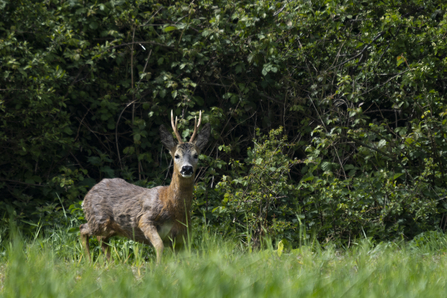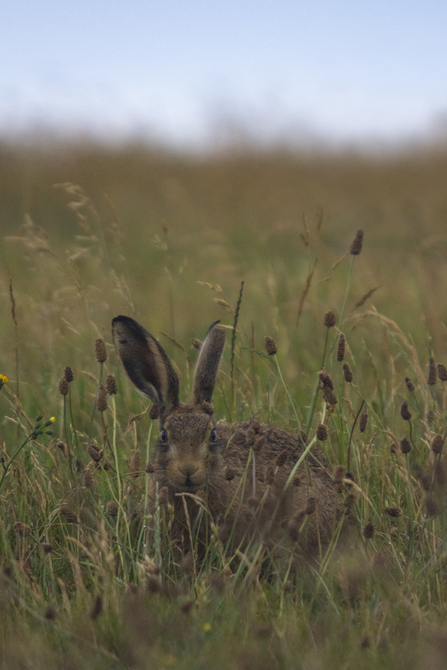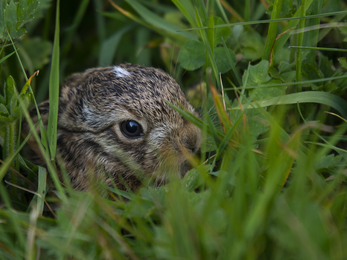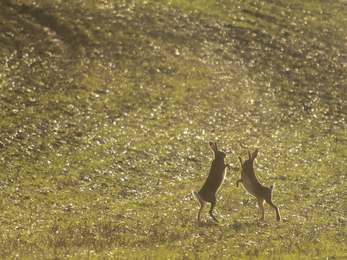For many, the beginning of Spring is a joyous occasion, celebrated by events held across the country. The swallows have now arrived, swooping across the fields, gobbling up the insects. The buzzing of the bees has become the backdrop to the rich melodies of birdsong. The bluebells poke their heads out from the soil, vibrant blue amongst the rich greens. The air is warm, heavy with the scent of gorse, with blossoms of blackthorn drifting in the breeze. Everywhere is teeming with life, from the rugged coastline to the barren moors.
Mammal Magic in Spring
An alert hare, Image by Rosie Brown
With the days getting longer and the wildlife beginning to awaken, this time of year is amazing for an early morning wander
With the days getting longer and the wildlife beginning to awaken, this time of year is amazing for an early morning wander, when the dawn chorus has begun, and the sun has not yet peeked over the hills. During these still mornings, I have often wandered the back lanes, along the hedgerows and through the fields to discover what surprises may be waiting for me.
Roe deer are a common sight, either hidden in the shadow of the hedges or grazing in the open, lit up by the soft morning light. I remember one morning where I was out walking across the fields and three roe deer shot out from behind a hedgerow – the local buck joined by two does. They bounded across the field; all I could do was watch, my heart hammering in my chest.

A roe buck, Image by Rosie Brown
Roe deer are often solitary, or live-in small groups. During the summer, their coats are a beautiful reddish-brown whilst in the winter it fades to a softer grey hue. They are small deer, with a very notable white rump. The bucks’ antlers are considerably smaller than its much larger relatives, having only three points when fully matured. They mate during the summer and are also the only hoofed animal in which delayed implantation takes place. This allows the doe to give birth during the spring months when the chances of survival for her young are greater. Does will give birth to one or two fawns, sometimes triplets.
The best time to see them is during dawn or dusk, and it is always a pleasure to watch them grazing in the fields. There is a majesty to them, much like other deer species, that is completely captivating. I have witnessed the local buck a few times over this past year slumbering in the fields during the day, curled up amongst the ferns and brambles.
Roe Deer in Lanhydrock by David Farrar (https://youtu.be/Qgc0q37Y8pA)
Roe Deer in Lanhydrock, Video by David Farrar
Another recent encounter actually happened from the comfort of my living room. I was sat on the sofa, typing away, drinking tea when, for no apparent reason, I glanced out the window. To my amazement, a stoat was running along our garden path and ran right past, only to slip away through a wooden fence. For a moment, I sat, gobsmacked. Then – I grabbed my camera and hurried out the door to look for it. Unfortunately, it had vanished.
Stoats are members of the mustelid family, the same as otters and badgers. They have a long, slender body with a brown coat, white chest, and black tipped tail. Stoats are commonly mistaken for weasels – but weasels lack the black tipped tail and are much smaller. Stoats are incredible hunters and will often take on rabbits five times their size, as well as chase rodents through their burrows and climb trees in search of bird’s eggs. They are solitary animals, only coming together to breed. In the spring, the jill – the name of a female stoat – will give birth to six to twelve kits. Like the roe deer, the stoat also delays implantation. They are active throughout the day; and seeing one is always an amazing experience. Despite their ferocity, they are incredibly charismatic animals as well as endearing.

A European Stoat in its natural habitat, Image by Andy Rouse/2020VISION
For the past year, I have been fortunate enough to have spent many a morning and evening in the presence of the brown hare. One of my most recent encounters was with a young female, oblivious to my presence, running towards me along a country lane. Once she noticed me, she paused in her stride, unsure. Tentatively, she came closer till she was within three feet of me. I was crouched down at this point; eye level to her. She shined golden in the light, her honey eyes watching me. After a few moments, she bounded away, pausing to look back before disappearing under a gate. I went home, grinning ear to ear.

Hare amongst the teasels, Image by Rosie Brown
Hares are synonymous with spring and new growth, often associated with Ostara/Eostre, the Goddess of Spring. They are known for their incredible speed, reaching up to 45mph. They are most active during dawn and dusk, and shelter in forms, shallow depressions in the earth where they will sit tight for hours on end. Although similar in appearance to rabbits, hares are far larger with a more chiselled look, with black tipped ears.
The females can give birth up to four litters a year, of two to four young, known as leverets. Leverets are born fully furred with open eyes and can protect themselves from birth. The mother will leave them in their own forms during the day; only visiting them once during night to feed. Leverets can be very inquisitive – I once had one come over and sniff my shoe!
The best time to see hares is early spring when the adults begin to ‘box’. Boxing hares are amazing to see, it is often a female warding off the advances of a male. They will leap, kick, claw, and bite at the other, chasing each other across the fields. I have been privileged enough to witness this, and it is one of my most treasured wildlife encounters. The two hares fought each other, fur flying, backlit by the setting sun – my mouth had hung open, in disbelief. The battle was over in a matter of seconds, but I was full of joy for the rest of the evening.
The hares have managed to wedge themselves firmly into my life this year, and I have been fortunate enough to spend many hours with them, in turn they offered me glimpses into their world of open fields and vast skies.
So, my advice is this: get outside! Spring is a magical season waiting to be explored, full of wonderful memories to discover and wildlife to meet, it would be a shame to miss any of it.



